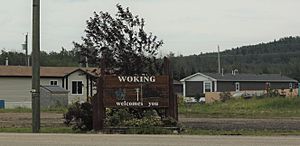Woking, Alberta facts for kids
Quick facts for kids
Woking
|
|
|---|---|

Woking's welcome sign
|
|
| Country | Canada |
| Province | Alberta |
| Census division | No. 19 |
| Municipal district | Saddle Hills County |
| Government | |
| • Type | Unincorporated |
| Area
(2021)
|
|
| • Land | 0.55 km2 (0.21 sq mi) |
| Elevation | 675 m (2,215 ft) |
| Population
(2021)
|
|
| • Total | 62 |
| • Density | 113.6/km2 (294/sq mi) |
| Time zone | UTC−7 (MST) |
| • Summer (DST) | UTC−6 (MDT) |
Woking is a small community known as a hamlet in northwestern Alberta, Canada. It got its name from a town called Woking in Surrey, England.
Woking is found in a region known as the Peace River Country. It is located north of the town of Sexsmith and south of the villages of Rycroft and Spirit River.
Discover Woking
Woking is a small, unincorporated community. This means it does not have its own local government like a city or town. Instead, it is governed by Saddle Hills County.
What is a Hamlet?
A hamlet is a very small settlement. It is usually smaller than a village and does not have its own local government. Hamlets are often part of a larger county or municipal district. Woking is a great example of a hamlet in Alberta.
Where is Woking Located?
Woking is located in a part of Alberta called Census Division No. 19. This is a way that Statistics Canada divides the province for counting people. Woking is also part of the federal area known as Peace River. This is the area that elects a representative to the Canadian Parliament.
Woking's Population Story
Every few years, Statistics Canada counts how many people live in different places across Canada. This is called a census.
- In the 2021 Census, Woking had a population of 62 people. They lived in 31 homes.
- In the 2016 Census, Woking had 102 people living there.
- In the 2011 Census, the population was 106 people.
This shows that the number of people living in Woking has changed over the years. The land area of Woking is about 0.55 square kilometers. This means that in 2021, there were about 113 people living in each square kilometer of land.


